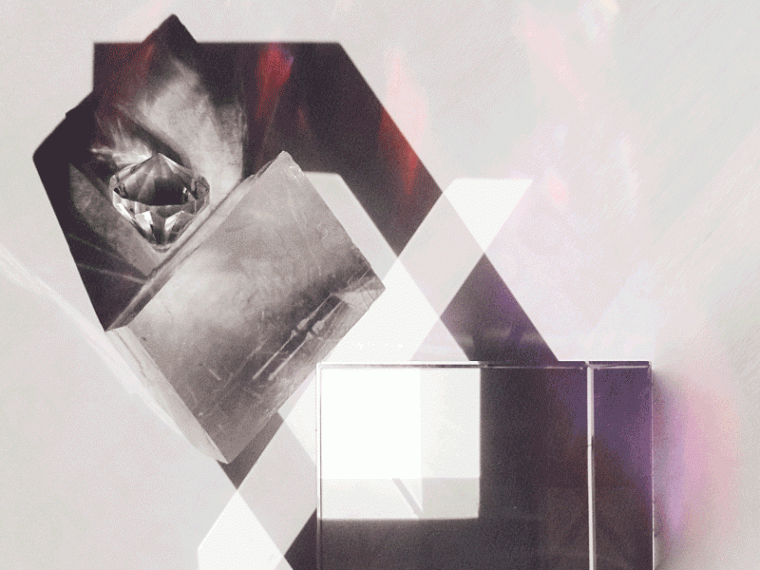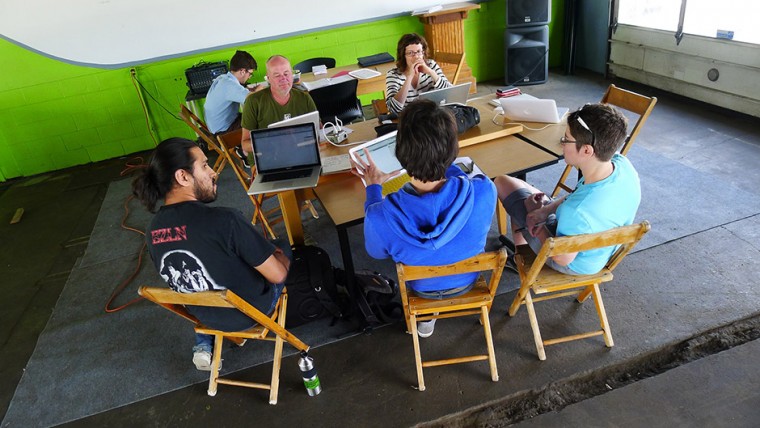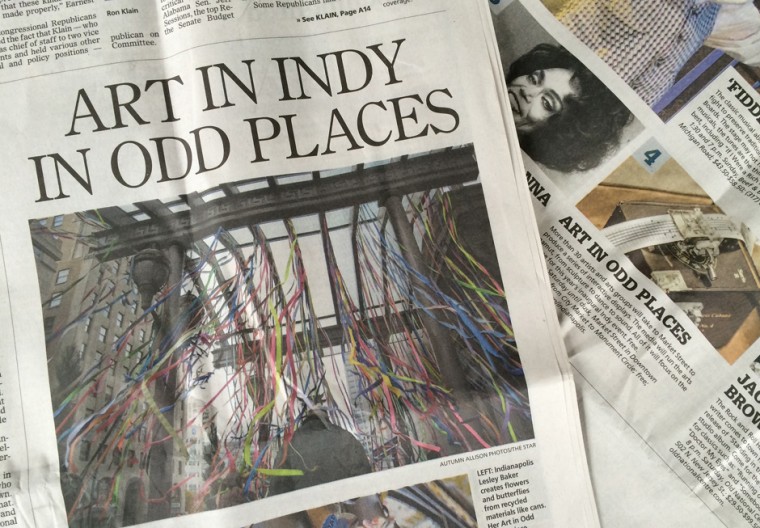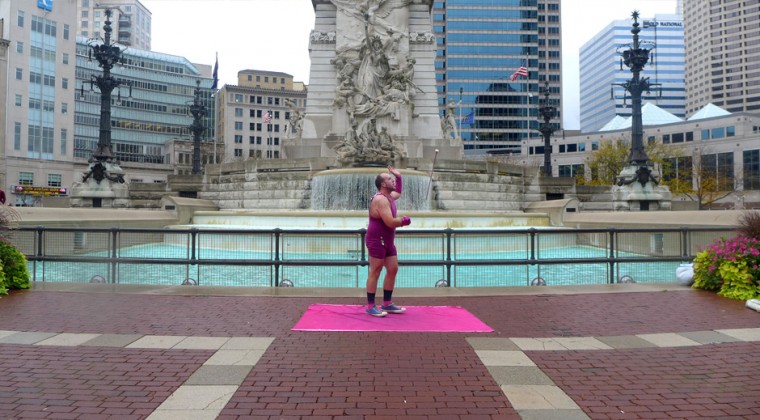Flannelly’s of the Future Festival
To celebrate their marriage and the role music played in bringing them together, artists Brelyn Gerard and John Flannelly organized an experimental music festival. Flannellys of the Future Festival will take place April 30, 4-10 p.m. at Tube Factory artpace, 1125 Cruft St. Several musical acts were part the formation of their relationship so the pair wanted to share the music with Indianapolis by means of a free concert. The bands that will be featured are: Bad Psychic (Bloomington), DJ Littletown, Duncan Kissinger, Exploding Head Scene (Philadelphia, PA), Glitter Brains (Bloomington), Oreo Jones & Sirius Blvck, Jeron Braxton & the Tamagotchis (Bloomington), Rev//Rev (Lafayette), Rob Funkhouser, Sedcairn Archives, Skything (Marlboro, Vermont), Teen Brigade (Lafayette).
“Both of us are the kind of people who strive to view life from as many angles as possible, to feel from all those angles even if it means crawling around the floor of the house to feel the space usually reserved for our knees and ankles, or chilling in the bathroom for a shift in perspective,” says Gerard.
Many of the musicians in the festival were part of Gerard and Flannelly falling in love. Flannelly’s music was the first time experimental music clicked for Gerard. “Sitting in our friend’s living room, watching John deliver the experience of his art, I had an ethereal space to sort through my feelings. It was a space that somehow managed to be safe and challenging at the same time,” says Gerard. “After his set at Free House, he threw the flower he’d been wearing on his vest to the audience. I seized it. To this day, that flower still graces my bookshelf.”
Soon after that, on Valentine’s Day 2015, Gerard and Flannelly enjoyed their first date — at the Fountain Square music venue Grove Haus. Gerard sang back up for the band Memory Foam. She found out that Flannely had toured with one of her favorite bands, Shame Thugs, and that he was in the music video for her favorite Sirius Blvck songs. Eventually, Flannelly moved from Bloomington to Indianapolis into Gerard’s friend’s house. After a recommendation from their mutual friend, artist Erin K. Drew, Flannely got a job at the same place where Gerard worked.
“Now, we’re getting married and we’re doing it our way. With all the art projects in the community we’re involved with, neither of us are interested in fussing over centerpieces and flowers. We want to celebrate our love by sharing the music we love, made by the people we love,” says Gerard. “We can’t wait to groove with Indianapolis at the Flannellys of the Future Festival!”
Gerard has a new book, iForgot, out and Flanney a new album, Peace and Quiet now available. For their honeymoon after the festival celebration, the two will travel the country to promote their works.
Julianna Barwick and Mas Ysa
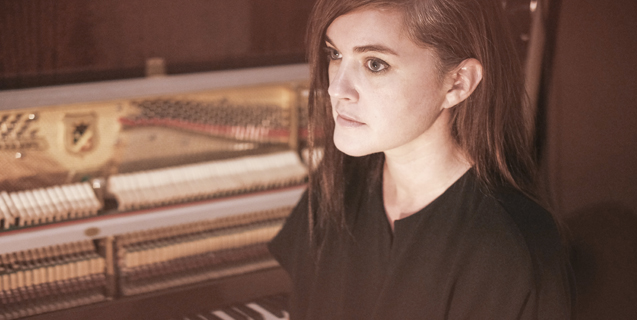 May 6th sees the release of Will, the revelatory third full-length album by Brooklyn experimental artist Julianna Barwick. Conceived and self-produced over the past year in a variety of locations, the ominous, compelling Will is a departure from 2013’s Alex Somers-produced Nepenthe. If that last record conjured images of gentle, thick fog rolling over desolate mountains, then Will is a late afternoon thunderstorm, a cathartic collision of sharp and soft textures that sounds looming and restorative all at once.
May 6th sees the release of Will, the revelatory third full-length album by Brooklyn experimental artist Julianna Barwick. Conceived and self-produced over the past year in a variety of locations, the ominous, compelling Will is a departure from 2013’s Alex Somers-produced Nepenthe. If that last record conjured images of gentle, thick fog rolling over desolate mountains, then Will is a late afternoon thunderstorm, a cathartic collision of sharp and soft textures that sounds looming and restorative all at once.Barwick’s life over the past several years has largely been lived in transit, and as such the genesis of Will was not beholden to location; Barwick worked on the album in a variety of locales, from a desolate house in upstate New York to the Moog Factory in Asheville, North Carolina to Lisbon, Portugal.
“I love touring, but it can be a wild ride,” Barwick reflects on this cycle of constant motion. “You’re constantly adjusting, assimilating, and finding yourself in life-changing situations.” Those experiences played into and helped shape Will’s charged, unstable atmosphere: “I knew I’d be playing these songs live, so I wanted some movement,” she explains. “Something that had rhythm and low-end.”
That sense of forward propulsion is largely owed to Will’s synth-heavy textures. The electric current that runs through the album takes on various shapes of intoxicating instability. Featuring contributions from Thomas Arsenault (Mas Ysa), Dutch cellist Maarten Vos and percussionist, Jamie Ingalls (Chairlift, Tanlines, Beverly), Will is largely a product of ups and downs, a reflection of a life lived somewhere in between transience and standing still. “While making this record, there were moments of isolation and dark currents,” Barwick admits. “I like exploring that, and I love when I come across songs that sound scary or ominous. I’ve always been curious about what goes into making a song that way.” The beguiling, beautifully complicated Will is the result of that curiosity, and proof of Barwick’s irresistibly engaging talent as a composer and vocalist.
Will comes off of Barwick’s busiest period in her career, following the release of Nepenthe—a spate of activity that included playing piano for Yoko Ono, performing at Carnegie Hall at the annual Tibet House concert with the Flaming Lips and Philip Glass, The Rosabi EP and beer created in conjunction with brewing company Dogfish Head, and a re-imagining of Bach’s “Adagio” from Concerto In D Minor.
Watch the Derrick Belcham-directed video for debut single, “Nebula” which was filmed in the Philip Johnson Glass House and presents the essence of Will and Julianna Barwick’s richly complex musical fabric.
Julianna Barwick’s music has been reviewed in Time Out New York, Time Out Lisbon, The New York Times, and The Village Voice, among other publications. Her music has also been featured as “Best New Music” on Pitchfork, which also gave, 2009’s “Florine” EP an honorable mention for an album of the year.
Mas Ysa
“Thomas Arsenault, the person who records as Mas Ysa, is difficult to pin down, and that’s probably the best thing about him. He’s lived in Montreal and San Francisco and Sao Paolo and New York and wherever Oberlin is. He’s scored modern dance productions and remixed synthpop groups. He sometimes sings in an angelic, reverby tenor and sometimes in a full, throat-wracked howl. He makes mostly electronic records, and he does it by itself, but “producer” somehow doesn’t seem like the right job title for him. (I’ve also seen people describe him as a “composer,” and that seems even more wrong.) Listening to his records, it’s hard to tell which sounds are electronic and which are made by actual physical instruments. His music drifts freely between ambient and synthpop and oblique dance and good old-fashioned indie rock. And he’s conclusively proven that you don’t need a full band to sound vaguely like Arcade Fire.
Mas Ysa made his name on last year’s Worth EP, which alternated between drifting, pretty synth-drone and big, chest-thumping psychedelic laptop-rock howlers. On Seraph, his first proper album, Arsenault pretty much smushes those two things together until they’re one thing, and the result is a pleasant drift that never settles on one genre for more than a few seconds and stays appealing and interesting throughout. All the individual sounds, like the glassy walls of keyboard on “Sick” or the happy-sigh New Order beeps of “Look Up,” have an impressive widescreen gloss to them. Arsenault’s voice has that quavery tone that was so popular among mid-’00s indie-dude singers, in which every word means so much that he just can’t choke it out without his throat catching. Some tracks play around with Euro-club house-thumps, which sounds shockingly good with this sort of singing and this sort of production. Nicole Miglis from Hundred Waters shows up on “Gun,” and her airy coo works as an absolutely lovely complement to Arsenault’s emotive gurgle. “Service” has some seriously badass Moroder-style Italo pulsing. There’s a lot to like here.
And maybe, for you, there will be a lot to love. Arsenault’s closest peer might be Youth Lagoon’s Trevor Powers, another indie auteur who pulls inspiration from wherever and whose songs seem to project meaning, even if you don’t necessarily know what that meaning is. Youth Lagoon has never really gotten past the “pleasant background music” stage for me, but that dude’s music means a lot to a lot of people. I suspect that the same will be true here. And even if you don’t end up loving this thing, it’s still an impressive piece of work, one that you should hear — if you can carve out the time. After all, there is a truly unprecedented amount of great music out there. If something is merely good, you can be forgiven for skipping it.”–Tom Breihan of Sterogum
This concert is made possible by The Andy Warhol Foundation for the Visual Arts. About The Andy Warhol Foundation for the Visual Arts: The Andy Warhol Foundation for the Visual Arts was established in 1987. In accordance with Andy Warhol’s will, its mission is the advancement of the visual arts. The Foundation’s objective is to foster innovative artistic expression and the creative process by encouraging and supporting cultural organizations that in turn, directly or indirectly, support artists and their work. The Foundation values the contribution these organizations make to artists and audiences and to society as a whole by supporting, exhibiting and interpreting a broad spectrum of contemporary artistic practice.
Prince Rama
Prince Rama is the musical duo of sisters Taraka and Nimai Larson. They have lived in ashrams, worked for utopian architects, written manifestos, delivered lectures from pools of fake blood, conducted group exorcisms disguised as VHS workouts, installed art installations at The Whitney, Art Basel and various galleries across the U.S. And now they return to Big Car April 9, 8 p.m. at the Tube Factory artspace, 1125 Cruft St. in the Garfield Park neighborhood on the south end of downtown.
They will perform Xtreme Now, an album about extreme sports with Indianapolis-based The Icks opening for them. The cost of the performance is $10 and tickets can be purchased on-line (https://www.eventbrite.com/e/prince-rama-indianapolis-us-tour-the-icks-tickets-21012549100) or at the door.
Xtreme Now is the most extreme album Prince Rama has ever made. Writing for Xtreme Now began while the Larson sisters were living on a black metal utopian commune on Vȫrmsi, a remote island off the coast of Estonia during the summer of 2012. There, Taraka had a near death experience inside an ancient Viking ruin, which sparked a recurring sense of time-schizophrenia, or the physical sensation of existing in multiple time periods simultaneously.
In this case, she experienced a joint-existence in both the medieval ages and the year 2067. In one of her prophetic visions she describes, “In the year 2067, I witnessed an aesthetic landscape where art museums are sponsored by energy drink beverages and beauty is determined by speed. I saw a vision of ancient tapestries stretched across half-pipes and people base-jumping off planes with the Mona Lisa smiling up from their parachutes. I saw art merge with extreme sports to form a new aesthetic language of ‘Speed Art.’ I realized that time travel was possible via the gateway of extreme sports, and I wanted to make music that would provide the score.”
Perceiving a great void in the world of extreme sports for music that could match the metaphysical intensity of these death-defying feats, Prince Rama set forth to make Xtreme Now, the first real foray by any musician to create a new “extreme sports genre.” For inspiration, the sisters looked to their own flirtations with death and time-dilation, along with countless hours of obsessively watching extreme sports videos and consuming dangerous quantities of Monster Energy drink.
Working with acclaimed dance producer Alex Epton of XXXChange (Gang Gang Dance, Björk, Spank Rock, Panda Bear, The Kills), the new songs take on a more powerful, confident, fierce, infectious, all-encompassing, and accessible dance-club feeling than any other Prince Rama record – a fearless, visionary pop tour de force for the ghost-modern era that celebrates the ephemerality of life, dancing just at the edge of death’s gilded smile.
About The Icks
The Icks utilize electricity to power their instruments. What if John Hughes directed Blade Runner?
John Caldwell-guitar and vocals
Cameron Holloway-farfisa
Joe Ferguson-bass
Amanda Case-vocals
$10
https://www.eventbrite.com/e/prince-rama-indianapolis-us-tour-the-icks-tickets-21012549100
This concert is made possible by The Andy Warhol Foundation for the Visual Arts. About The Andy Warhol Foundation for the Visual Arts: The Andy Warhol Foundation for the Visual Arts was established in 1987. In accordance with Andy Warhol’s will, its mission is the advancement of the visual arts. The Foundation’s objective is to foster innovative artistic expression and the creative process by encouraging and supporting cultural organizations that in turn, directly or indirectly, support artists and their work. The Foundation values the contribution these organizations make to artists and audiences and to society as a whole by supporting, exhibiting and interpreting a broad spectrum of contemporary artistic practice.
Urban creatives
by Cara Courage, Thinker in Residence
I’m back in the UK now after my near-month with Big Car and although Indy is around 4000 miles away, the place and people still feel close; I talked in my first blog about the ‘magic’ of the type of art work – social practice – that Big Car does and sat here at my desk now in Brighton, UK, it appears that a magic has left its mark on me.
My role with Big Car as Thinker in Residence gave me a special licence to get involved with the team but also remain somewhat separate to it too. In this role I was neither artist nor community member, but me, a researcher with a 15-year career in the arts, that was an extra pair of hands and someone to bounce ideas off.
This place I inhabited has led me on to think of the term ‘urban creatives’. Urban creatives is a term that I am increasingly using to describe that group of people that come together in a social practice art project to make it happen. This will be artists, community members, maybe also architects, planners, engineers… The point is though that in an urban creative group whoever is in it, all work in equal regard of each other’s skills – the artist is expert at being the artist, that planner at being the planner, and, as social practice artist Jeanne van Heeswijk states, the community is expert at being the community. Each can act on their expertise and each will also learn from the interactions with others.
This is certainly my experience of Big Car and Indy. During my time there I found myself in a group with all sorts of skills and backgrounds, where each was valued for what they bring and was encouraged to act on this. At the same time, the open dialogue was set to foster learning between ourselves. So whilst I saw people given the space and permission to be who they are I also saw people change as an outcome of this gathering of skills. I saw this spread out too from the local projects that Big Car is engaged in to the wider creative and cultural fabric of Indy, spreading through the networks, conversations, and institutions that comprise that scene.
In my first blog I posited that the magic in these projects came from them being fun and social and useful and I stand by that still now. I also said that it’s down to the people involved that make them magic and that’s certainly been underlined for me with Big Car – this is a very unique set of people without doubt. But to move this a little further, my initial unpacking of my thoughts from my month with Big Car and in Indy is that it’s not just the outcomes of what Big Car does but the how of what it does that makes it special. Like any special practice art, it is the varied elements of the process coming together in their myriad ways that makes these projects magic. It values people and brings out in them potential they may not have realised they had and puts this to use, gives it a social value.
Fun Times at Art in Odd Places
Thanks to everyone who participated, sponsored and presented as part of Art in Odd Places Indianapolis. Hundreds of people experienced surprising installations, traffic-stopping performances, and lively interactions with the 27 creative interventions presented Oct. 17-18. Big Car Collaborative’s project–the As You Wish desk–fulfilled over 100 wishes with on-the-spot objects made from paper, clay, and more. WISH-TV Channel 8 did a nice video piece. Check out photos on Flickr and at IndyStar.com.
AiOP Indy was a collaboration of Big Car, Classical Music Indy, Arts Council of Indianapolis and Indianapolis Museum of Art, with financial support from Big Car, Delta Faucet, the Arts Council of Indianapolis, Indy Mod Homes, Downtown Indy, Apparatus IT, Sun King, and KA+A, and promotional support from NUVO and IndyHub.
Art In Odd Places Indy
by Cara Courage, Thinker in Residence
Art in Odd Places comes to Indy tomorrow and Saturday, two days of art installations and performances around Monument Circle and Market Street to City Market, from dawn until dusk. Ed Woodham, the AIOP founder gave a lecture on the project at IUPUI this week; one of the students asked Ed how he gauges the public’s perception of the work, and this is a pertinent question of art in the public realm – does seeing these interventions have a lasting effect on people or is that effect, like the art itself, just momentary?
Art interventions that are momentary, that have a limited temporality, I call splash interventions – they are dropped into the urban realm like a pebble in a river, make a splash and are then gone. How one measures the impact that these have on the people that see them or may interact with them is a question I have had of my research for some time.
There is a growing voice that sees splash interventions as opening up the meaning of urban space – what can happen in it and done by whom – and reimagines the city.
The temporary nature of this artform opposes fixed meanings of spatial use; this is a porous practice with a ‘loose’ unintended use of space designed to engage passers-by in a moment of play or reflection. These moments are unpredictable and transitory and open up sanctioned meanings of city space. Here, the function of splash interventions is to jolt people’s assumptions about the use of space and from this spark imagination or reflection, or both, and stimulate interest in the place around them. This enhanced or renewed connection to place for some is a process of engagement through alienation or dislocation, the disruption of the expected urban norm makes the lived experience of it active, not passive, the jarring of the arts encounter in the urban space paradoxically creating a connection to it. This will then go on to encourage human interaction in the urban realm that is again different to the norm, which creates a new collective urban experience and strengthens social bonds.
These are grand claims to make. I question how deep this practice is – does this have an impact past the moment of interaction to the next day, or longer? I also question if anything more than a moment of play, of a break from the norm during lunch hour or the walk to work, is the aim of all splash artists.
I have certainly seen splash interventions recreate the city as a space where rules are suspended, make the city become a spontaneous space that is open to a variety of uses and encourage people to express themselves in a different, less formal, way. This is something I am looking forward to seeing over the next two days with AIOP Indy.

